Nepean Summer Peony Care: Tips for Bigger Blooms Next Year
Quick Peony Summer Care Summary:
- Deadhead Spent Blooms: Cut faded flowers just above healthy leaves.
- Leave Foliage Intact: Let leaves work all summer to store energy.
- Water Deeply: Soak soil thoroughly when dry, avoid wetting leaves.
- Fertilize Sparingly (If At All): Avoid high nitrogen; focus on root health.
- Monitor Pests/Diseases: Check for mildew/blight; ants on buds are OK.
- Plan Fall Cutback: Cut foliage to ground *after* it yellows/browns (usually Oct).
- Consider Support: Plan for grids/stakes next spring to prevent flop.
Need help keeping your garden gorgeous? Request your free quote today!
Introduction: Nepean's Peony Passion & Prepping for Next Year's Pomp
Well hello, fellow Nepean garden lovers! Wasn't this spring's peony show absolutely spectacular? Across our neighbourhoods, from Barrhaven right over to Manotick, those big, beautiful blooms certainly put on a display. Peonies are like the rock stars of the late spring garden – they show up, look amazing, and then vanish almost too quickly, leaving us wanting an encore!
But here’s a little secret known to seasoned gardeners: just because the main performance is over doesn’t mean the work stops. In fact, what you do *now*, during the summer months, plays a huge role in how magnificent next year's peony pomp will be. Think of it as backstage prep for the next big show! Giving your peonies the right attention after they flower is key to building strong roots and ensuring they have the energy stored up for fantastic blooms next spring.
So, let's roll up our sleeves (but maybe after finding some shade!). This guide is your friendly roadmap to simple summer peony care. We'll cover the essential landscaping and gardening tasks – like deadheading, feeding, and watering wisely – to guarantee your beloved plants are rested, recharged, and ready to wow us all again next year. Check out some of our past projects on our transformations page!
Post-Bloom Pampering: The 'Now What?' After the Flowers Fade
Okay, the big peony party is over. Those gorgeous blooms have done their dazzling dance, and now you're left looking at... well, slightly less dazzling stalks. It's the "Now What?" moment every peony parent faces. Don't worry, this isn't the time to ghost your peonies! Think of this phase as their spa day, essential pampering to recharge for next year's floral fireworks. Giving them the right attention now sets the stage for future success.
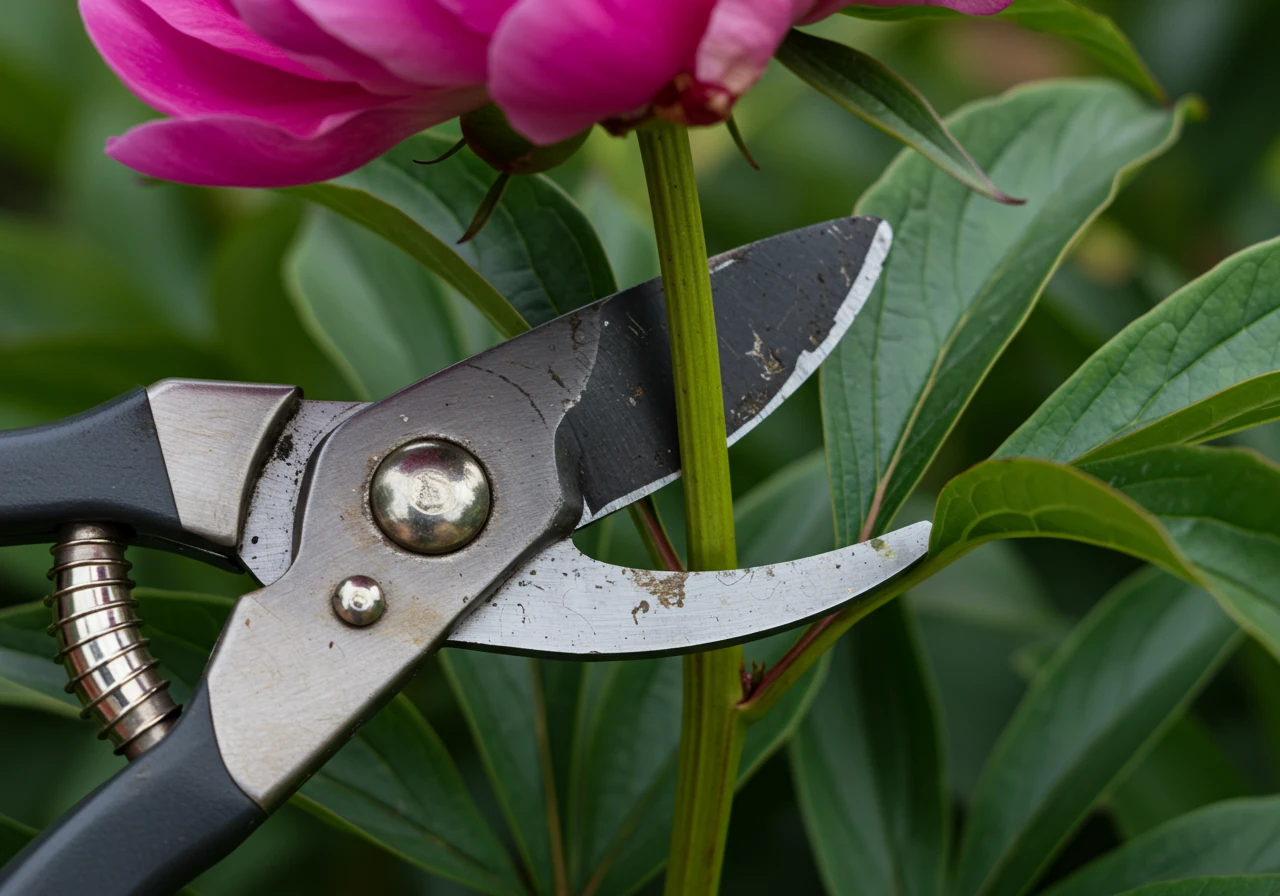
First up: Deadheading. This just means removing the spent flowers. Why bother? Because letting them go to seed tells the plant, "Okay, job done for the year!" We want it to focus its energy on building strong roots and healthy leaves, not making seeds nobody asked for. It also keeps things tidy and helps prevent diseases that love decaying flowers, especially during humid Ottawa summers.
Here’s the super-simple deadheading how-to:
- Grab your clean pruning shears or snips. Clean tools prevent spreading yuckiness!
- Follow the stem down from the faded flower head.
- Snip the stem off just above the first set of full, healthy leaves. Don't cut it right down to the ground yet!
Speaking of leaves, resist the urge to cut back the foliage right after blooming! Those green leaves are the plant's solar panels, busy making food (through photosynthesis, fancy!) all summer long. This energy gets stored in the roots, powering next spring's growth and those big, beautiful blooms we love in neighbourhoods like Barrhaven and Greely. Cutting them back too soon is like unplugging their charger halfway – not cool! Let the foliage live its best life until it naturally starts to yellow and die back in the fall. Proper foliage care is a cornerstone of successful gardening.
Keep an eye out for any signs of disease, like powdery mildew or botrytis blight, which can creep in when it's damp. Good air circulation helps, so don't overcrowd your plants. If you spot trouble, remove affected leaves immediately and dispose of them in the garbage, not the compost. These simple sanitation steps are part of good Nepean Fall Garden Health Checks that start *now*.
While your lawn might benefit from specific treatments like Nepean Spring Lawn Aeration Ottawa to improve soil structure, your peony beds need consistent moisture (but not soggy feet!) through the summer. Water deeply when the soil feels dry a couple of inches down. Proper watering now helps the plant immensely, just like ensuring proper Nepean Irrigation Winterization to Avoid Pipe Damage prevents headaches later. This summer care blends right into smart Nepean Fall Garden Prep for Colour and Winter Tips, ensuring vigorous plants next year. And hey, if all this sounds like a bit much, remember there are always professional Landscaping and Gardening Services available to lend a hand, including Nepean Yard Cleanup!
Summer Sustenance: Watering & Feeding for Future Glory
Alright, team peony! The flower show might be over, but keeping our leafy friends happy through the Ottawa summer heat is crucial for next year's encore performance. Think of July and August as their "recharge season." Just like we need water and snacks to power through a Nepean heatwave, your peonies need the right kind of summer sustenance. But spoiler alert: they're surprisingly low-maintenance!
Watering Wisdom: Go Deep, Not Shallow
When it comes to watering peonies during the summer, the golden rule is deep watering. Forget those quick, shallow sprinkles that barely dampen the surface. That just encourages shallow roots, making plants stressed when things get dry. We want to encourage deep, strong roots that can find moisture even when the topsoil is parched.
How often? It depends on Mother Nature and your soil. Stick your finger about two inches into the soil near the base of the plant. If it feels dry, it's time to water. Give them a good, long soak, letting the water penetrate deeply. Using a soaker hose or watering wand at the base is ideal, keeping water off the leaves which helps prevent fungal issues (a common headache in humid Ottawa summers!). Need advice on Ottawa conditions? Check out resources like the Master Gardeners of Ottawa-Carleton.
Soil type plays a big role here. Much of Nepean has heavier clay soil, which holds moisture longer but needs water to soak in slowly to avoid runoff. In contrast, areas like Greely or Osgoode might have sandier loam, which drains faster and needs watering more frequently.
- Clay Soil Tip: Water slowly and deeply, less often. Ensure good drainage.
- Sandy Soil Tip: Water more frequently, but still deeply, as water drains quicker.
Consistent watering is a key part of summer landscaping maintenance. If managing the watering schedule feels like another chore on the list, remember that various Lawn and Garden Care Services can help keep your whole yard looking great. Don't forget about mulching and edging to help retain moisture.
Feeding Facts: Less is More!
Here’s some great news: peonies are not greedy eaters, especially in summer. After they bloom, they're busy storing energy in their roots, not putting on leafy growth. Pushing them with too much fertilizer now, particularly high-nitrogen types, can lead to weak, floppy stems and, ironically, fewer flowers next year. Nobody wants that!
If you didn't feed them in the spring, a very light snack in early summer is okay, but definitely not required if your soil is healthy. Think about using:
- A small handful of bone meal scratched into the soil around the drip line (the area under the edge of the leaves). This provides phosphorus for root and flower development.
- A thin layer of well-rotted compost around the base (but not touching the stems). This improves soil structure and adds nutrients slowly.
Good soil is the foundation of healthy plants, reducing the need for constant feeding. Investing in proper Soil Preparation Techniques when planting pays dividends for years. You can see the amazing difference good care makes by browsing through some garden Makeover Success Stories.
Ultimately, keeping the area around your peonies weed-free is often more beneficial than adding extra fertilizer. Weeds compete for water and nutrients! Keeping beds tidy is a core part of any good maintenance plan, something included in services like our Ottawa Yard Cleanup Service or specialized options like the Marionville Yard Cleanup Service. Remember, while these tips are generally effective, results can vary based on your specific garden conditions – think of it like the gardening version of reading the fine print, which you can explore in our Service Terms and Conditions and Privacy Policy.
Keeping Critters & Crud Away: Summer Pest & Disease Patrol
Okay, let's talk about the uninvited guests that might crash your peony party during the summer – the critters and the crud! Keeping your plants healthy means playing detective sometimes. Here’s your patrol guide using our handy tab interface:
Ants on Buds: Friend or Foe?
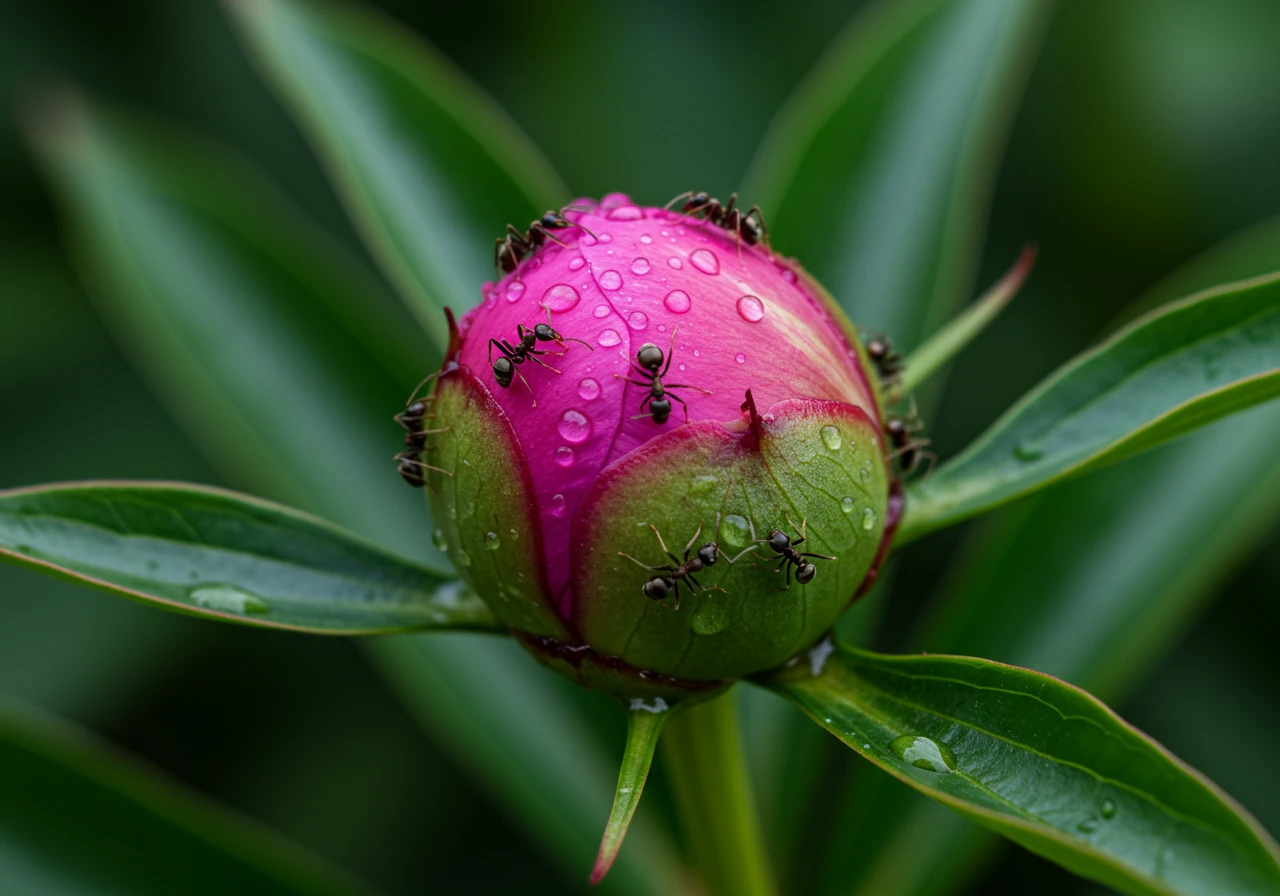
Question: Ah! My peonies are crawling with ants! Are they eating my buds?!
Answer: Relax, take a breath! This is probably the *most* common question peony growers ask. The good news is: ants on peony buds are totally normal and *not* harmful to the plant itself. Peony buds secrete a sweet, sugary nectar that ants find irresistible. Think of it as a tiny energy drink stand just for them. They lap up the nectar and, in return, might even chase off other less desirable insects. Once the flower opens and the nectar dries up, the ants will move on to find snacks elsewhere. No need for sprays or panic! They aren't damaging the bloom. Just let them enjoy their little treat – maybe give them a tiny Thank You wave (okay, maybe not).
Powdery Mildew Woes
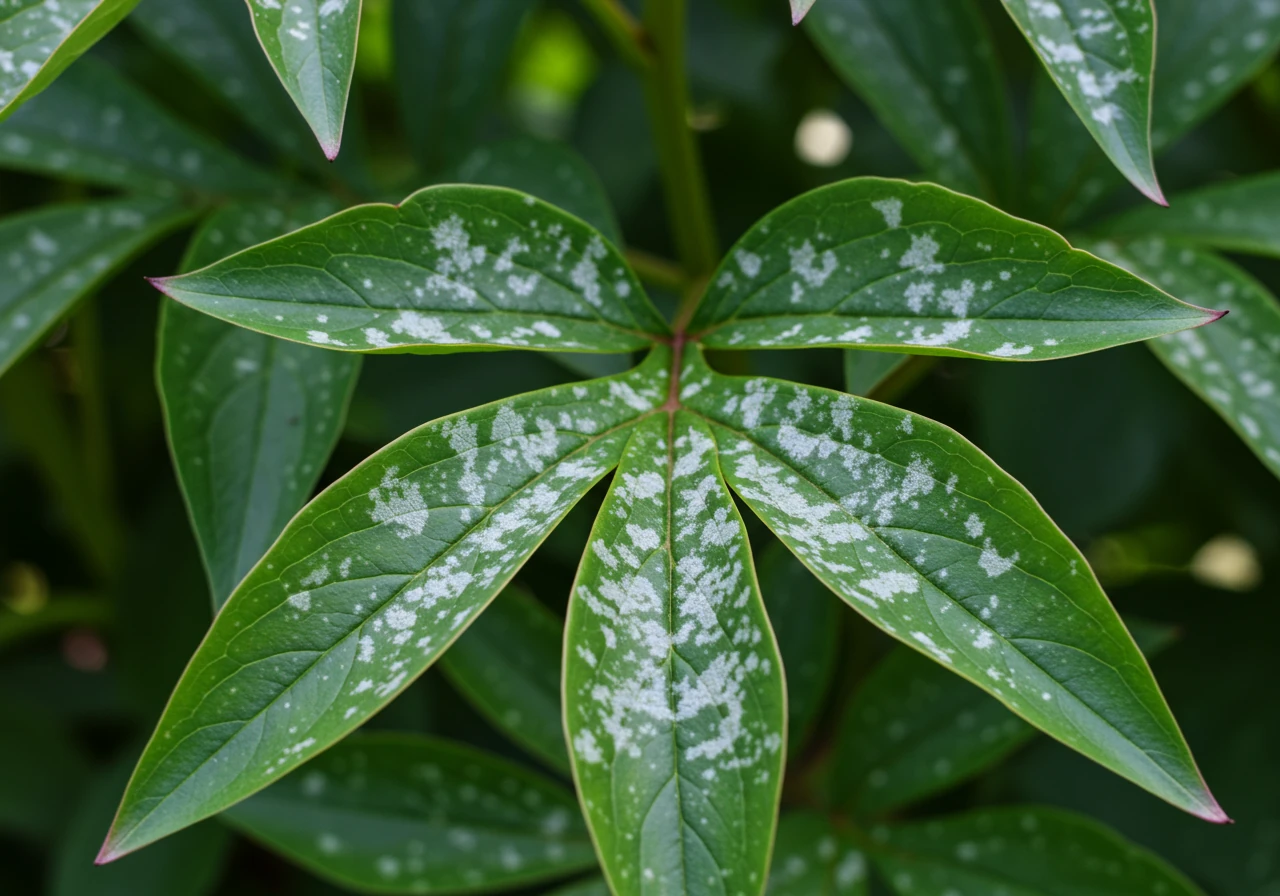
Question: Help! My peony leaves are getting covered in a white powdery coating. What gives?
Answer: Ah, the dreaded powdery mildew. This fungal foe loves warm, humid conditions – sound familiar, Ottawa summers? Especially in lovely areas near the Rideau like Manotick or Kars where humidity can linger. It looks like someone dusted your leaves with flour. While it rarely kills peonies, it looks ugly and can weaken the plant over time.
- Prevention is Key: Good air circulation is your best friend. Ensure your peonies aren't overcrowded. Proper spacing right from the start, like considering plant placement during a professional Garden Design and Installation, can make a huge difference later on. Also, water the soil at the base of the plant, not the leaves, and preferably in the morning so foliage dries quickly. Learn more about local planting conditions at the Friends of the Experimental Farm.
- Treatment: If it appears, prune out the worst affected leaves immediately. Dispose of this material in the garbage, not your compost bin, to prevent spreading. Keeping the garden tidy through regular maintenance, maybe even as part of a larger City Yard Cleanup Service, helps remove potential disease sources. For stubborn cases, eco-friendly options like horticultural oil or soap sprays can sometimes help, but focus on prevention first! Our team knows how to handle common Ottawa garden issues.
Battling Botrytis Blight (Grey Mould)
Question: I'm seeing grey, fuzzy mould, especially on old flowers or stems. Is this bad?
Answer: That sounds like botrytis blight, another fungal disease that thrives in damp, cool conditions, but can persist into summer, especially if old blooms aren't removed. It often starts on fading flowers and can spread to stems and leaves, causing them to rot.
- Prevention & Treatment: Sanitation is crucial! Deadhead spent flowers promptly (like we talked about earlier!). Remove any infected plant parts *immediately* – cut back to healthy tissue using clean pruners. Again, dispose of infected material properly; don't compost it. Ensuring good air circulation helps immensely. Keeping the entire yard clear of decaying debris, perhaps with help from a City Property Cleanup Service or Metcalf Property Cleanup Service if things get overwhelming, reduces places for fungi to hide. Healthy, vigorous plants are always more resistant, which is why consistent care leads to the kind of stunning Garden Makeover Success Stories we love to see.
Remember, a little vigilance goes a long way in keeping your peonies pest and disease-free through the Ottawa summer! Regular checks are part of good city garden maintenance.
Setting the Stage for Slumber: Late Summer & Early Fall Prep
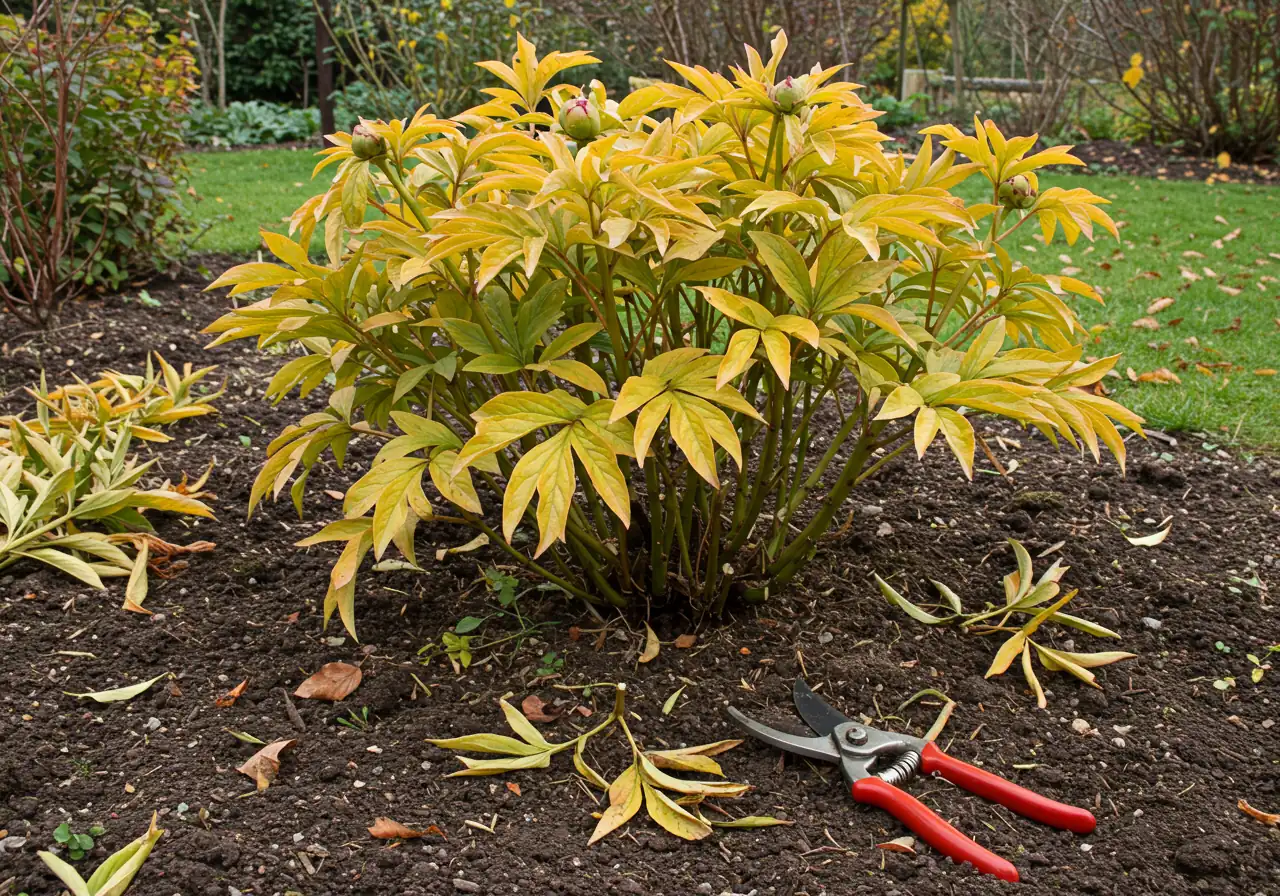
Okay, garden friends, as the late summer sun starts casting longer shadows and those crisp Ottawa mornings hint at sweaters, it's time to shift our focus. The vibrant greens are fading, and our peonies are getting ready for their big sleep. Think of this late summer and early fall period as preparing their cozy winter bed – less about fluffing pillows and more about smart gardening practices to ensure they wake up refreshed and ready to bloom next spring!
Late Summer (Aug-Sept)
Continue deep watering if conditions are dry. Stop all fertilizing. Keep an eye on foliage; let it decline naturally. This energy storage phase is vital.
Early Fall (Late Sept-Oct)
Monitor foliage closely, especially after the first light frosts. Wait for leaves to turn yellow or brown – this signals dormancy. Don't rush the cutback!
The Big Chop (Mid-Fall - Oct)
Once foliage is fully died back (yellow/brown), use clean pruners to cut stems down to about 2 inches (5 cm) above the ground. Timing varies in the Ottawa area (Nepean vs. Metcalfe, etc.).
Crucial Cleanup! (Mid-Fall - Oct/Nov)
This is non-negotiable! Remove *all* cut stems and fallen leaves from the area. Dispose of this debris (do not compost) to prevent overwintering diseases/pests. A thorough cleanup like our Metcalf Garden Clean Up Service or City Garden Clean Up Service is key.
To Mulch or Not? (Late Fall - Nov)
Optional: After the ground *starts* to freeze lightly, apply 2-3 inches of loose mulch (shredded leaves, straw). Keep it pulled back slightly from the crown to prevent rot. Helps moderate soil temps.
Why the Cleanup Crew is Crucial
Now, here’s the non-negotiable part: you *must* clean up all the cut stems and fallen leaves. Don't just leave them lying there over winter! This debris can harbor fungal spores (like botrytis blight we talked about earlier) and insect eggs, just waiting for spring to arrive so they can cause problems. Bag it up and dispose of it – don’t add diseased peony foliage to your compost pile. A thorough fall tidy-up is essential preventative medicine for your garden beds. Keeping things neat prevents future headaches and is a cornerstone of good garden health, whether you tackle it yourself or get help from a dedicated Ottawa Garden Clean Up Service for that end-of-season blitz. It's a vital part of year-round plant health, much like the tasks handled by a routine City Garden Maintenance Service. Consider the benefits of professional property clean up for larger areas.
To Mulch or Not to Mulch?
Ah, the mulching debate! In our chilly Ottawa climate, a layer of winter mulch can be beneficial, *but* with caveats.
- Pros: Mulch helps insulate the roots from the jarring freeze-thaw cycles common in our winters. This is especially helpful for newly planted or divided peonies whose root systems aren't fully established. Well-chosen sites during the initial Planning Your Perfect Garden Installation also contribute to winter survival.
- Cons: Applying mulch too early or too thickly can trap moisture around the crown (where the stems emerge), leading to rot – peonies hate wet feet! It can also provide a cozy winter hideout for voles or other critters.
The Verdict: If you choose to mulch, wait until the ground has started to freeze lightly (usually late October or November). Apply a loose mulch like shredded leaves, straw, or pine boughs, about 2-3 inches deep. Crucially, keep the mulch pulled back slightly from the very center (the crown) of the plant to allow air circulation. While your focus might be shifting towards fall Lawn Care Tasks like prepping for sod installation next year, taking a moment for proper peony prep pays off.
Taking these steps shows you care about the long-term vitality of your garden, a philosophy we deeply believe in – you can learn more About Our Approach to Yard Care. A little prep now ensures your peonies slumber soundly and wake up ready for another spectacular show! Find inspiration on our Google My Business page too.
Don't Let Your Peonies Flop! Supporting Next Year's Stars
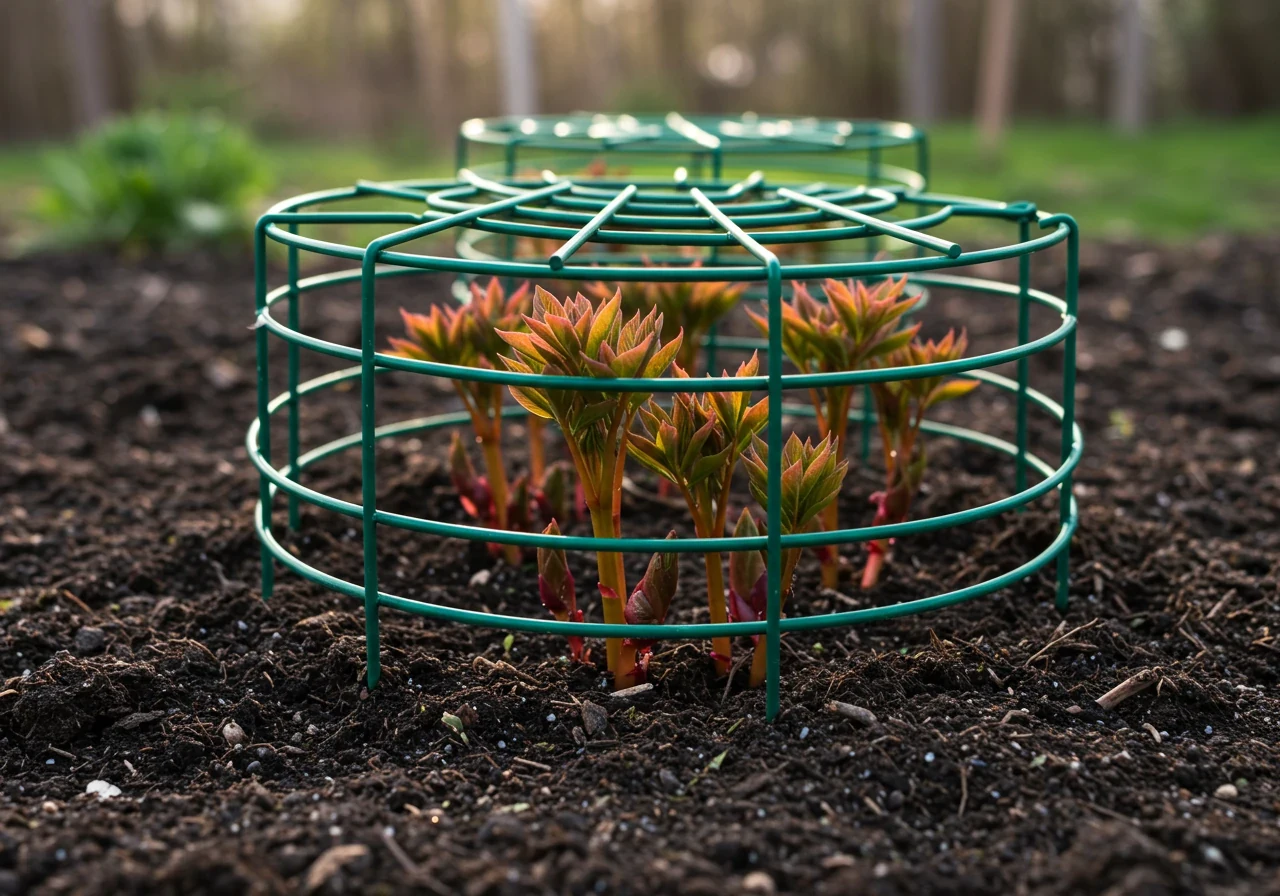
Ah, peonies. We adore those big, blousy blooms! But let's be honest, sometimes they get a little... dramatic. One heavy Ottawa rain shower or just the sheer glorious weight of those flowers, and *whomp* – they're face down in the mud. It's the dreaded peony flop! While a little bowing is natural, a full-on collapse isn't just messy; it hinders air circulation and can even break stems. Especially with those magnificent, established clumps you see gracing gardens in Nepean or Richmond, sturdy support is practically essential landscaping.
So, how do we keep next year's stars standing tall? Planning *now* for support *next spring* is the key. Here are a few popular options:
- Grow-Through Grids or Rings: These are fantastic if you get them in place *early*. You position the grid (often metal or plastic-coated wire) over the plant when it's just starting to sprout, maybe 6-8 inches tall. The stems grow up through the openings, and the foliage eventually hides the grid. Pros: Nearly invisible, provides even support. Cons: You MUST install them early; forget, and it's too late! Ensure the area is clear of winter debris before installation; a tidy space makes everything easier, whether handled by you or a service like the Metcalf Property Cleanup Service or Marionville Property Cleanup Service.
- Stakes and Twine: The classic DIY method. Place several stakes (bamboo, metal, or sturdy branches) around the perimeter of the clump and loop garden twine around them, corralling the stems. Pros: Inexpensive, adjustable. Cons: Can look a bit obvious, twine might cut into stems if too tight, may need re-tying as the plant grows.
- Wire Cages: Think sturdy tomato cages (sometimes used upside down for wider support). Pros: Reusable, strong. Cons: Can look utilitarian, might not be the right size for every peony clump.
- Linking Stakes: These are individual stakes with hooks or loops that link together to form a custom-sized support structure. Pros: Versatile, adjustable. Cons: Can be pricier than basic stakes.
Timing is Everything! The absolute best time to put *any* support system in place is early next spring, just as the reddish peony shoots are emerging and are about 6-10 inches tall. Trying to wrangle a half-grown peony into a support cage is like trying to put toothpaste back in the tube – messy and frustrating! Clearing away old leaves and debris from the previous season is step one – if you had broken supports last year, getting those cleared during a fall service like the Metcalf Garden Clean Up Service or Marionville Garden Clean Up Service makes spring setup much smoother. Proper support is a key part of ongoing Garden Maintenance, preventing damage before it happens.
Think about what support worked (or didn't!) this year. Planning ahead now means you'll be ready to give your peonies the backup they need for a flop-free performance next spring! If considering professional help with spring garden prep, including support installation, we always appreciate hearing from you via our Estimate Feedback form. A little planning and early action ensures those gorgeous blooms stay upright and beautiful!
Key Takeaways: Your Nepean Peony Power-Up Plan
Alright, Nepean neighbours, feeling powered up? We've covered the essential post-bloom pampering for your beloved peonies. Think of this as your cheat sheet, your quick reference guide to ensuring those beauties come back bigger and better next spring. No need to feel overwhelmed – a little timely gardening TLC goes a long way! Here’s your Nepean Peony Power-Up Plan, boiled down:
- Snip Smartly Post-Show: Once the flowers fade, deadhead them by snipping the stem just above the first full set of leaves. But leave the green foliage alone all summer – it's their food factory, working hard to store energy for next year! Think of it as charging their batteries.
- Water Wisely, Not Weakly: Through the hot Ottawa summer, give your peonies a deep drink when the soil feels dry a couple of inches down. Forget little sprinkles; encourage those roots to go deep. Consistent watering is key landscaping maintenance, preventing stress during dry spells.
- Summer Snacks? Go Light: Peonies aren't big summer eaters. If you feed them after blooming, use only a tiny bit of bone meal scratched in around the drip line or some compost spread nearby (not touching stems). Mostly, focus on keeping weeds away – they steal the good stuff! Considering amending your soil next year? Proper soil is vital, and you can learn more about Choosing the Right Soil and Mulch to give your plants the best base.
- Bug Watch & Crud Control: Ants on buds? Totally fine, they're just sipping nectar! White powdery stuff (mildew) or grey mould (botrytis)? Not fine. Prune affected bits immediately, keep things tidy, and ensure good air circulation. Removing garden debris helps prevent issues – a thorough cleanup, like that offered by a Comprehensive City Yard Cleanup Service, reduces hiding spots for diseases over winter. Sometimes a larger area needs attention, similar to the jobs handled by a dedicated Marionville Garden Clean Up Service.
- The Fall Foliage Finale: Patience pays off! Don't cut the foliage back until it turns yellow or brown, usually after a good frost (typically October in Nepean or nearby Barrhaven). Then, cut stems down near the ground and clean up all the fallen leaves and stems meticulously. This step is crucial for preventing overwintering pests and diseases.
- Tuck-In Time (Optional Mulch): A light layer of loose mulch (straw, shredded leaves) applied after the ground starts to freeze can protect roots from harsh freeze-thaw cycles common in our Ottawa winters. Remember to keep it pulled back slightly from the plant's crown to prevent rot! Proper Mulching and Edging matters.
- Plan for No-Flop Flowers: Hate seeing those magnificent, heavy blooms kiss the dirt after a rain shower? Decide now what kind of support (grow-through grids, stakes, cages) you'll use next year. The key is to install it *early* next spring when the shoots are just emerging and easy to guide.
Following these steps sets your peonies up for spectacular success! It’s all about timely care and understanding what your plants need throughout the seasons. Feeling confident? Fantastic! Got more questions about your specific garden situation, or thinking about getting some professional help with your yard chores? We're always happy to chat, so feel free to Get in Touch with Our Team. And hey, if you've recently received an estimate from us for any yard work, we genuinely value your input – please take a moment to fill out our Quick Estimate Feedback Form. Happy peony prepping!
Nepean Peony FAQs: Your Questions Answered!
Got peony perplexities? You're not alone! These gorgeous plants can sometimes leave us scratching our heads. Here are answers to some common questions we hear from fellow gardening enthusiasts around Nepean and Ottawa.
Oh, the frustration of flower FOMO (Fear Of Missing Out)! Often, peonies planted too deep won't bloom well. Ensure the 'eyes' (pink buds on the roots) are only 1-2 inches below the soil. Too much shade (they need 6+ hours of sun!) or excessive nitrogen fertilizer (making leaves, not flowers) are other likely culprits. Young plants sometimes just need a year or two to establish in our Ottawa climate.
Patience is key here! The prime time for dividing peonies in the Ottawa region is definitely fall, usually September or early October. This gives the new divisions enough time to grow some roots before the ground freezes solid. Dividing in spring often means sacrificing that year's blooms. Tackling division after fall foliage cleanup makes the whole process much smoother gardening.
You bet! Most classic herbaceous peonies are incredibly hardy and laugh off Ottawa winters (they actually need the cold!). Itoh peonies (intersectional hybrids) are also fantastic choices – very tough, often with sturdy stems. Just ensure any variety you pick is rated for Zone 4 or colder for peace of mind. These reliable bloomers are mainstays in local landscaping. The City of Ottawa often has resources on recommended plants, check their tree planting program page for related info.
The dreaded peony flop! Planting near a protective structure like a fence (but allowing air circulation) helps. The best defence is installing supports early next spring – think grow-through grids or sturdy rings placed when shoots are small. Ensuring the surrounding area is tidy helps too; sometimes a full Property Clean Up can remove potential wind hazards before they become an issue, whether in Richmond or requiring Ottawa Property Cleanup Service.
Ah, that familiar Ottawa clay! Improving drainage and structure is vital. Working generous amounts of organic matter, like compost or well-rotted manure, into the bed before planting works wonders (see our Soil Preparation info). For existing plants, top-dressing annually with compost helps. Clearing out old debris first with a service like the Ottawa Garden Clean Up Service or even specialized cleanups like the Metcalf Yard Cleanup Service makes amending the soil much easier.
Absolutely! Every garden has its own quirks. If you're facing a unique peony puzzle or need tailored landscaping suggestions for your space, sometimes talking it through is the best approach. Please feel free to Reach Out for Personalized Garden Advice. We're happy to help solve garden mysteries, whether for a small city plot or larger areas needing something like the Marionville Yard Cleanup Service.
Conclusion: Blooming Brilliant in Nepean Next Spring!
And that’s a wrap, Nepean garden pals! See? Giving your peonies the star treatment after they bloom isn't rocket science, but it *is* the secret sauce for a truly spectacular show next spring. Remember, the TLC you provide now – from snipping spent blooms correctly to that essential fall tidy-up – directly fuels next year's magnificent flower power. It's all about setting the stage for future gardening glory!
We're excited for you and your peonies! Have a great tip that works wonders in your Nepean, Kanata, or Embrun garden, or maybe a photo of your favourites starting their journey to next year's bloom? Share the inspiration with fellow Ottawa flower fans – we'd love to see! If you're puzzling over a particular landscaping issue or need tailored advice for your green space in Nepean, Manotick, Greely, Osgoode, or Richmond, please Reach Out for Personalized Garden Advice. And hey, when time is tight, don't forget our Yard Cleanup and Garden Maintenance Services are ready to help handle the heavy lifting. Here’s to seeing your gardens bloom brilliantly next spring!

